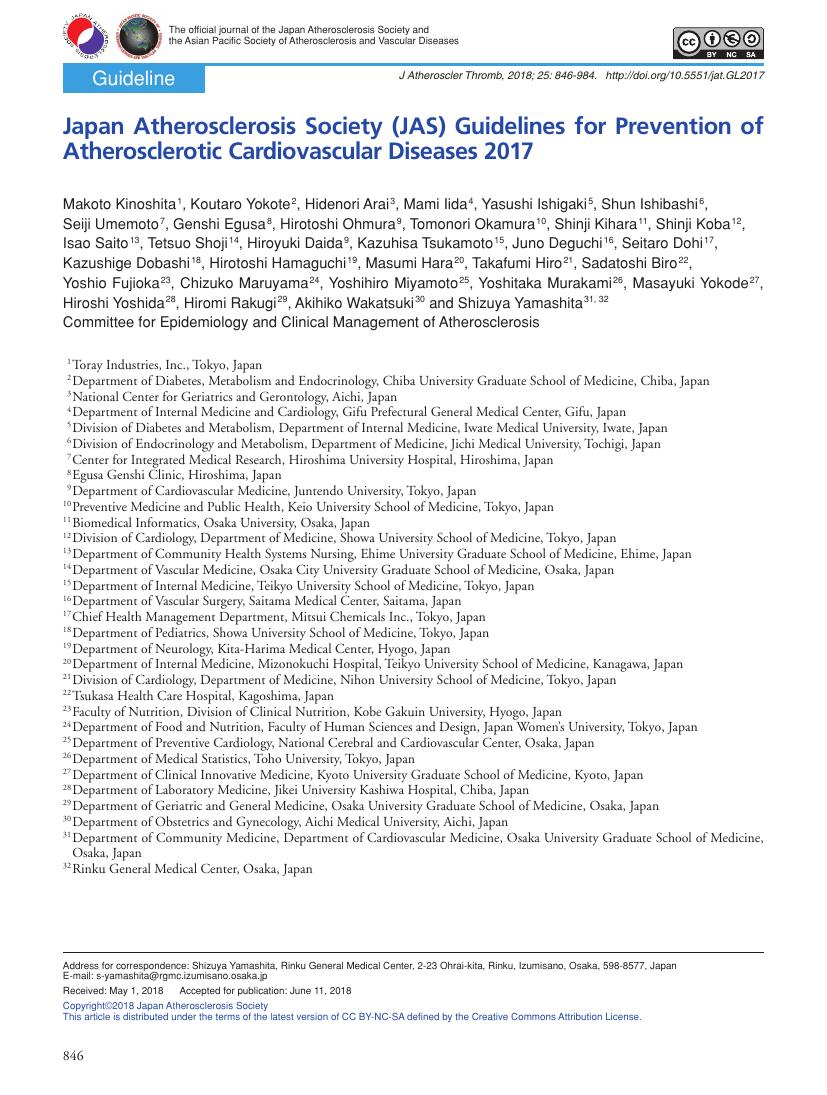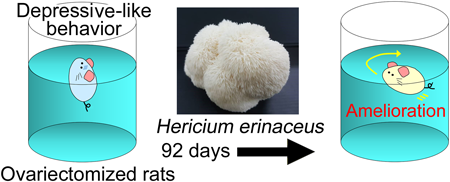- 著者
- Makoto Kinoshita Koutaro Yokote Hidenori Arai Mami Iida Yasushi Ishigaki Shun Ishibashi Seiji Umemoto Genshi Egusa Hirotoshi Ohmura Tomonori Okamura Shinji Kihara Shinji Koba Isao Saito Tetsuo Shoji Hiroyuki Daida Kazuhisa Tsukamoto Juno Deguchi Seitaro Dohi Kazushige Dobashi Hirotoshi Hamaguchi Masumi Hara Takafumi Hiro Sadatoshi Biro Yoshio Fujioka Chizuko Maruyama Yoshihiro Miyamoto Yoshitaka Murakami Masayuki Yokode Hiroshi Yoshida Hiromi Rakugi Akihiko Wakatsuki Shizuya Yamashita Committee for Epidemiology and Clinical Management of Atherosclerosis
- 出版者
- Japan Atherosclerosis Society
- 雑誌
- Journal of Atherosclerosis and Thrombosis (ISSN:13403478)
- 巻号頁・発行日
- vol.25, no.9, pp.846-984, 2018-09-01 (Released:2018-09-01)
- 参考文献数
- 999
- 被引用文献数
- 347 534
- 著者
- Mariko Harada-Shiba Hidenori Arai Shinichi Oikawa Takao Ohta Tomoo Okada Tomonori Okamura Atsushi Nohara Hideaki Bujo Koutaro Yokote Akihiko Wakatsuki Shun Ishibashi Shizuya Yamashita
- 出版者
- Japan Atherosclerosis Society
- 雑誌
- Journal of Atherosclerosis and Thrombosis (ISSN:13403478)
- 巻号頁・発行日
- vol.19, no.12, pp.1043-1060, 2012 (Released:2012-12-20)
- 参考文献数
- 85
- 被引用文献数
- 144 146
Familial hypercholesterolemia (FH) is a highly prevalent autosomal dominant hereditary disease, generally characterized by three major signs, hyper-low-density-lipoprotein (LDL) cholesterolemia, tendon/skin xanthomas and premature coronary artery disease (CAD). Because the risk of CAD is very high in these patients, they should be identified at an early stage of their lives and started on intensive treatment to control LDL-cholesterol. We here introduce a new guideline for the management of FH patients in Japan intending to achieve better control to prevent CAD. Diagnostic criteria for heterozygous FH are 2 or more of 1) LDL-cholesterol ≥180 mg/dL, 2) tendon/skin xanthoma(s), and 3) family history of FH or premature CAD within second degree relatives, for adults; and to have both 1) LDL-cholesterol ≥140 mg/dL and 2) family history of FH or premature CAD within second degree relatives, for children. For the treatment of adult heterozygous FH, intensive lipid control with statins and other drugs is necessary. Other risks of CAD, such as smoking, diabetes mellitus, hypertension etc., should also be controlled strictly. Atherosclerosis in coronary, carotid, or peripheral arteries, the aorta and aortic valve should be screened periodically. FH in children, pregnant women, and women who wish to bear a child should be referred to specialists. For homozygotes and severe heterozygotes resistant to drug therapies, LDL apheresis should be performed. The treatment cost of homozygous FH is authorized to be covered under the program of Research on Measures against Intractable Diseases by the Japanese Ministry of Health, Labour, and Welfare.
- 著者
- Azliza Mad Anuar Akira Minami Hiroshi Matsushita Kanako Ogino Kosei Fujita Hatsune Nakao Shota Kimura Vikineswary Sabaratnam Kaoru Umehara Yuuki Kurebayashi Tadanobu Takahashi Hiroaki Kanazawa Akihiko Wakatsuki Takashi Suzuki Hideyuki Takeuchi
- 出版者
- The Pharmaceutical Society of Japan
- 雑誌
- Biological and Pharmaceutical Bulletin (ISSN:09186158)
- 巻号頁・発行日
- vol.45, no.10, pp.1438-1443, 2022-10-01 (Released:2022-10-01)
- 参考文献数
- 59
Estrogen deficiency during menopause causes a variety of neurological symptoms, including depression. The edible Lion’s Mane mushroom, Hericium erinaceus (Bull.: Fr.) Pers. (HE), is a medicinal mushroom that has the potential for a neuroprotective effect and ameliorating neurological diseases, such as depression, anxiety, and neurodegenerative diseases. HE contains phytoestrogens, including daidzein and genistein. However, the ameliorating effect of HE on menopausal symptoms is not well understood. Here we investigated the impact of methanol extract of the HE fruiting body on depressive-like behavior in postmenopausal model rats. The activation of estrogen receptor alpha (ERα) causes body weight loss and uterine weight gain. Body weight gain and uterine weight loss by estrogen deficiency in ovariectomized (OVX) rats were reversed with 17β-estradiol (E2) but not with HE. Thus, the phytoestrogens in HE may hardly activate ERα. Estrogen receptor beta (ERβ) is expressed in the brain, and activation of ERβ ameliorates menopausal depressive symptoms. Notably, depressive-like behavior in OVX rats evaluated in forced swim test was reduced by administration of not only E2 but also HE for 92 d. Long-term activation of ERα increases the risk of breast and uterine cancers. HE, therefore, may be effective in treating menopausal depression without the risk of carcinogenesis caused by ERα activation.

